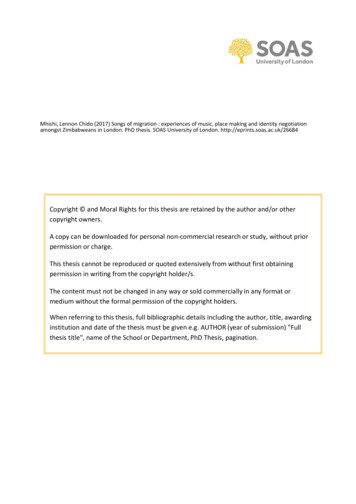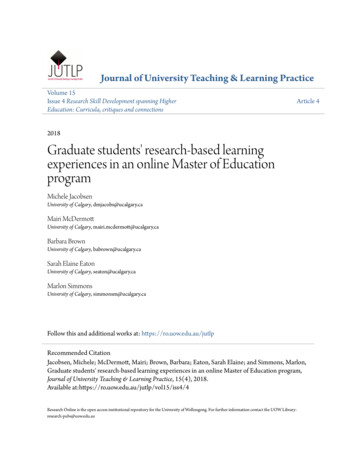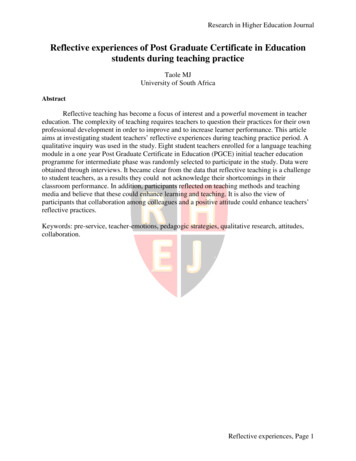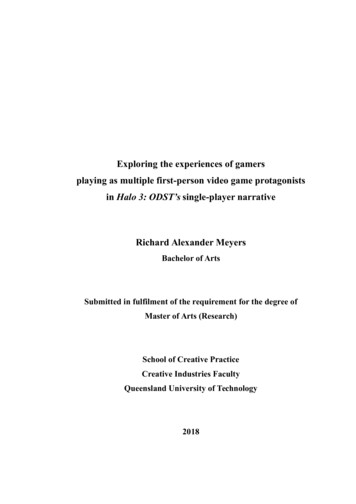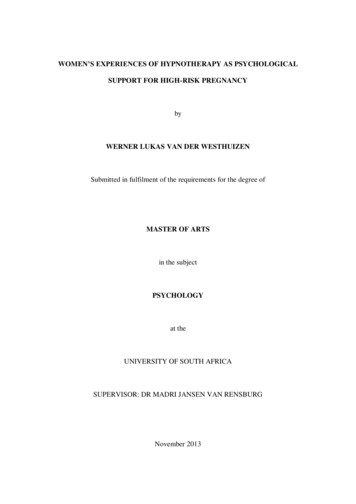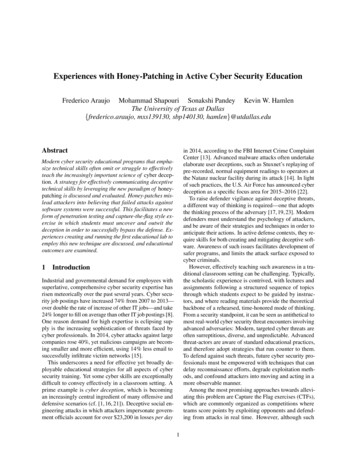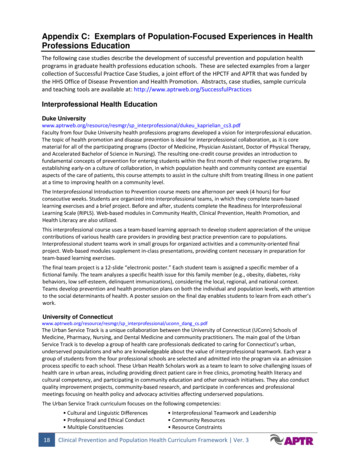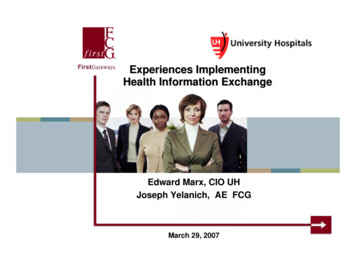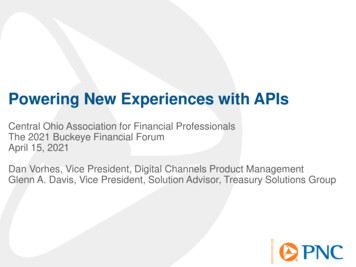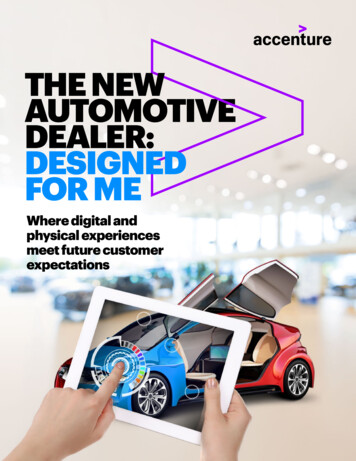
Transcription
Where digital andphysical experiencesmeet future customerexpectations
DEALERSHIPSDEAD? THINKAGAIN!Dealerships will remain the lynchpin of theautomotive distribution chain and customerinteraction—but not in their current form.The automotive dealerships of the futurewill be networked mobility hubs thatengage, entertain and delight customers,and now is the time to start creating them.
For today’s car buyers, accustomed to segueingseamlessly from online to offline and being recognizedas individuals throughout their shopping journeys, theoften impersonal, sales-target-driven atmosphere ofmany traditional, physical automotive dealerships canbe frustrating (See Figure 1).Most people who bought new cars from astandard dealership in the past would not doso again in the future. Sixty-three percent ofrespondents in an eBay survey said they wouldlikely buy online instead.1 Growing numbersare actually leaving vehicle ownership behind,preferring instead to hail or share a vehiclefor specific periods and purposes—mostly,moreover, online.And customers’ after-sales expectationsare moving in the same direction. Accordingto our research, nearly half of all drivers(45 percent) want service to be integratedseamlessly into their daily life: they don’twant to have to go in person to a workshopor dealer service location.2Yet, people also still want the human touch:a place where they can get to physical grips withthe vehicle they covet and receive expert adviceabout what it can do for them before they buy,hire or share it. The dealership experience,however, must be a frictionless, and digitallyenhanced extension of the customer experienceonline. And because customers won’t wait,OEMs and dealers need to start enabling it now.FIGURE 1:AS CONSUMERS ENGAGE WITH A BRAND, THEY COMPARE THEIR EXPERIENCEWITH THE BEST OFFERINGS ACROSS ALL INDUSTRIESBrands and services thathave changed customerexpectations and raisedthe bar for your brandPERCEPTUALINFLUENCERSHave influencedoverall customerexpectationsAirbnbCurrent services andexperiences that have(partially) replaced theneed for your productsEXPERIENTIALCOMPETITORSHave disruptedexpectations acrossthe automotiveindustrySuperb experiences areno longer limited to bestin-class in the industryDIRECTCOMPETITORSAre continuouslyrefreshing their productsand services that competedirectly with youGoogleAmazonBlaBlaCarTeslaCarwowAppleUberOther OEMsSource: AccentureTHE NEW AUTOMOTIVE DEALER: DESIGNED FOR ME3
DISRUPTORS, DRIVERSAND “ME”Today’s automotive customers are channel-agnostic.They expect meaningful, personalized treatment whenthey visit an OEM’s website and a physical dealer. In fact,they don’t differentiate between dealer and OEM. Andtheir expectations are being shaped by their experiencesas customers of other, digitally disrupted industries.Take, for example, the rise of products-asa-service, which has been impacting theautomotive industry for some time. Uber, whichfuses car, driver and app to deliver a ride hasbeen one of the leaders in this space; whileconstant advances in vehicle technology,especially electric and autonomous capabilities,are reinforcing the trend to mobility-as-a-service.Accenture research suggests that by 2030,automotive industry profits from vehicle hiring,sharing and similar mobility services are likelyto surpass those from vehicle sales3.Consider too the influence of the “me” economy,which leverages data on individual customers todeliver personally relevant content and uniqueexperiences, regardless of touchpoint. TheFrance-based beauty business Sephora hasbecome a global brand thanks to its successful,digitally enabled blending of both online andin-store customer “communities”4.Leading OEMs recognize, of course, thatcustomers’ expectations are escalating—andthat digitally disruptive competitors pose4THE NEW AUTOMOTIVE DEALER: DESIGNED FOR MEa threat to their traditional business model.What’s more, they’ve responded in kind to thedigital challenge, investing in digital media, carconfigurators and their online presence. Casein point: the data-driven in-car digital assistantsnow being incorporated into models built byBMW, Ford, Nissan, Hyundai, Daimler and others5.For the most part, however, the car makers’digital efforts remain partial and piecemeal. Theystill tend to see digital as an end in itself, ratherthan as an “invisible” enabler of the seamless,personalized and engaging experience acrossall touchpoints that today’s customers expect(see Technology: the “invisible” enabler).While incumbents in many other industriesaccelerate the shift to both smart marketplaces(which disrupt traditional business models toserve increasingly connected customers), andthe digital enterprise (which uses digital toboost operations and sales)—the automotiveindustry lags behind. Neither OEMs nor dealersare currently doing enough to maintain acompetitive advantage.
TECHNOLOGY:THE “INVISIBLE” ENABLEROEMs have certainly dabbled in digital, andnot only to enhance the product. While theirshowrooms (and sales staff) use Virtual Reality(VR) and Augmented Reality (AR) tools andcapabilities, smart goggles and interactivetouch screens are no substitute for frictionlessshopping.Instead of seeing digital as an end in itself,OEMs and dealers need to start leveraging it asa behind-the-scenes tool, facilitating theoptimal customer experiences they seek todeliver, but not defining them.Digital is no longer the centrepiece of the brandexperience in any industry. As interactionswith users evolve from periodic on-screenengagements to connected customerexperiences, companies need to create newservices that are deeply integrated in thephysical world. The time has come to blendthe digital with the physical6 (See Figure 2).Consider, for instance, Amazon GO, the onlineretailer’s venture into physical conveniencestores, where largely invisible technology doesaway with the need for lines and checkouts, butwhere customers can also touch and feel whatthey’re buying7.FIGURE 2:ENHANCING THE CUSTOMER EXPERIENCE BY BLENDINGTHE DIGITAL WITH THE LOYALTYSmartRepairVirtualEngagement ivingExperienceExclusive &Custom OfferOngoingEngagementPrior ToHandoverBrandAdvocacyEnhanced ExperienceThrough In-CarAssistancePhysicalDigitalDIGITAL AS AN INVISIBLE ificialIntelligenceAnalyticsTHE NEW AUTOMOTIVE DEALER: DESIGNED FOR ME5
THE IMPERATIVESOF CHANGEThere is a lot at stake for both parties in this brave newdigitally disrupted world. Dealers are already grapplingwith fewer visitors, high staff turnover and slumpingprofitability. The average annual turnover of sales people inthe US automotive business is 67 percent8, and between2016 and 2017 the profitability of the average USdealership was cut in half9.Furthermore, with third-party aggregators and online marketplaces encouragingautomotive customers to demand more for less, or go elsewhere, OEMs urgently need tostart building a consistent, cross-channel perception of their brands. Our research andexperience suggest that four immediate actions will support the necessary transformation:1. DIVERSIFY FORMATSDifferent customers like to interact in different ways. And there are now avariety of formats to choose from, including traditional dealerships, pop-up stores,service outlets, experience centers, mega-stores and flagship retail showrooms.Nevertheless, the data shows that car buyers spend 60 percent of their timeresearching online10, and nearly half (45 percent) want aftersales service “with aswipe”. In view of the critical importance of personal data to the delivery ofseamless customer experiences, 92 percent of customers surveyed would givetheir vehicle data to workshops, and 47 percent of those would do so for free11.By establishing new formats, OEMs can attract more customers, but they alsoneed to make customers’ preferred formats more accessible to them. Somehave diversified with new retail formats that co-exist with traditional dealerships:Hyundai and Jaguar Land Rover in the UK have enabled showrooms wherecustomers take control, and can buy a vehicle either in store or online, and wherestaff don’t have to meet sales targets. Similarly, in the used-car market, SonicAutomotive has established sensory environments in so-called EchoParks thattie the brand’s digital and physical assets into a seamless, flexible and compellingshopping experience12. There is no reason why OEMs and dealers can’t delivera similar brand boost in a harmonized way.6THE NEW AUTOMOTIVE DEALER: DESIGNED FOR ME
2. ABANDON OLD ATTITUDESA number of established beliefs and preconceptions are stopping OEMs anddealers from working effectively together. These range from “only the dealerknows the customers’ needs” to “customers focus only on price”, and from “siloedorganizations never change” to “new retail formats are unprofitable”—and justabout all of them are myths.With its own hybrid store and dealer network, Tesla has led the abandonment ofold attitudes in the industry. The electric vehicle pioneer has also stuck to a fixedprice, no discount strategy13.3. LEVERAGE NEW DISRUPTIVE TECHNOLOGIESFive are especially critical. Big Data and Analytics, which are the key to reallyknowing the individual customer; Blockchain, which gives controlled data accessto all relevant parties; Artificial Intelligence (AI), which allows machines to sense,comprehend, act and learn; Voice Control, which enables customers to engageseamlessly with providers; and Immersive Reality, which superimposes computergenerated content on real-world environments.Mackevision, part of Accenture Interactive and a market leader in ComputerGenerated Imagery (CGI), has elevated the connected retail experience to anotherlevel by using a Single Source Publishing Principle (SSP) to develop completeand integrated systems in which computer-generated content is created once,maintained in a central location, and can be utilized as often as desired. As aresult, automotive customers always receive content where and when they needit, based on their personal interaction history14.4. EMBRACE AN EXPANDED ECOSYSTEMFrom digital marketplaces and digital dealerships to online financing and vehiclerental services, disruptors and start-ups are piling into the automotive retailspace—and poaching customers. By embracing these newcomers as ecosystempartners, OEMs and dealers would not only mitigate the threat they pose, butalso complement their own capabilities, and drive more business.Consider, for example, Carwow, which consolidates the best offers from localand national dealers in the UK15 ; or the Fair.com app, which analyzes users’personal finances to assess which cars they can afford, and then presents themwith a range of options16.THE NEW AUTOMOTIVE DEALER: DESIGNED FOR ME7
COLLABORATE TOSUCCEEDIf OEMs and dealers don’t start working closer together, theyrisk being replaced by digital disruptors—and potentiallybecoming obsolete. If, however, they can enable a morecollaborative relationship then they will secure a leadingrole in the automotive retail landscapeof the future (See Figure 3). Here s how.FIGURE 3:THE NEW AUTOMOTIVE DEALER: DESIGNED FOR ME. CALL TO ACTIONENGAGEEVERYWHERE,ANYHOWINVISIBLE ENABLERSTO ENHANCE PHYSICALEXPERIENCEDATA-DRIVENRETAIL Living marketing Digitize the backboneof the business Share data New retail formatintegration Speak with one voiceDrive customerengagements througha single voice, usingliving marketing and newretail formats—besidestraditional ones.8 Recognize, personalizeand empower Measure thebusiness impact ofevery interaction Incentivize “customergeniuses” Enable a data-drivenworkforceCreate physical andsensory experiencesthat are “invisibly”enabled by digital.Build a data-drivenculture where sharingdata is seen as valuable,not a risk.THE NEW AUTOMOTIVE DEALER: DESIGNED FOR ME
ENGAGE EVERYWHERE, ANYHOWLiving marketing: Proactively develop an integrated customer-lifecyclecontact and engagement plan that drives conversion, loyalty, service retentionand re-purchase by responding to the customer needs “of the moment”.New retail format integration: Provide a personalized customer experienceacross all formats and channels, wherever the customer chooses to engage.A conversation started on webchat, for example, should continue seamlessly atthe dealership.Speak with one voice: Integrate all channels (including direct sales ande-commerce) as the digital revolution steadily streamlines the chain. For example,a customer should be able to configure the car they personally want online, whileat home and seamlessly be able to negotiate the price at the dealership.INVISIBLE ENABLERS TO ENHANCE PHYSICAL EXPERIENCEDigitize the backbone of the business: Enable frictionless interactionsbetween customers and staff. Guided sales tools that integrate all relevantinformation could include a web-based CRM system enabled by digital toolsand devices and integrated with aftersales.Recognize, personalize and empower: Leverage data to get to know eachcustomer personally and understand when to engage with them and how. Employdigital tools that automatically recognize the customer when they enter theshowroom or workshop.Incentivize “customer geniuses”: Empower all customer-facing staff to beproduct and experience experts with a bonus incentive that encourages them tostrive toward a common goal: delighting the customer.DATA-DRIVEN RETAILShare data: Share data across all siloes and structures so everyone has a “singleview of the customer”, including their wants and needs. Leverage collected datato benefit the customer first—providing a better experience based on what isknown about the customer, and driving growth at dealers and OEMs.Measure the business impact of every interaction: Not only analyzecustomer fe
Take, for example, the rise of products-as a-service, which has been impacting the automotive industry for some time. Uber, which fuses car, driver and app to deliver a ride has

